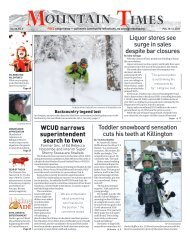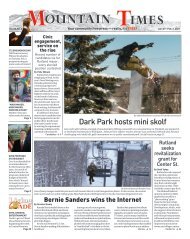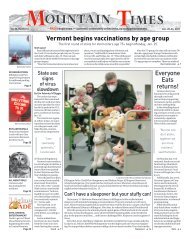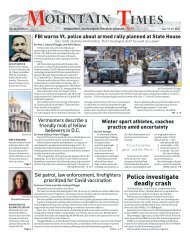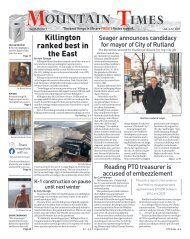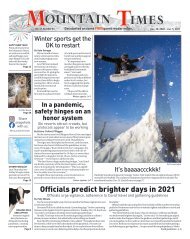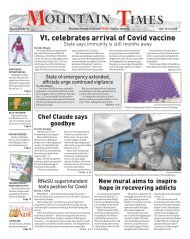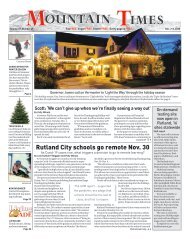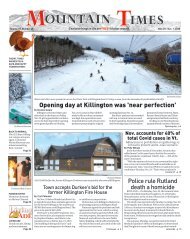Mountain Times Volume 49, Number 13: March 25-31, 2020
You also want an ePaper? Increase the reach of your titles
YUMPU automatically turns print PDFs into web optimized ePapers that Google loves.
Columns<br />
24 • The <strong>Mountain</strong> <strong>Times</strong> • <strong>March</strong> <strong>25</strong>-<strong>31</strong>, <strong>2020</strong><br />
Around the middle of <strong>March</strong>, I begin to feel that<br />
springtime urge to hit the road, to lace up the winterneglected<br />
running shoes and start slogging through<br />
some miles. My early-season<br />
jogs take me past a wetland<br />
area that stubbornly spans both<br />
sides of a road near my home.<br />
It’s a usual – and very welcome<br />
– happening to spot red-winged<br />
blackbirds here, even while snow<br />
lingers around the cattails and<br />
The Outside<br />
Story<br />
By Meghan<br />
McCarthy<br />
McPhaul<br />
Yes, it is I…looking “forward”<br />
instead of “back” in my column.<br />
Why? Because we all need something<br />
to look<br />
forward to in<br />
a world that<br />
has changed<br />
in what<br />
seems like<br />
a “New York<br />
minute!”<br />
So, for as<br />
long as these<br />
difficult days<br />
last I will<br />
attempt to<br />
brighten all of our days by reminding<br />
us of what Mother Nature will<br />
be doing to cheer us up. “She”<br />
has already started if we just look<br />
around.<br />
The crocuses on the Woodstock<br />
Avenue side of the Godnick Center<br />
are one of the first signs of spring.<br />
brushy willows.<br />
Red-winged blackbirds are<br />
among the earliest migrating<br />
birds to return in spring. The<br />
males seem natural show-offs,<br />
with their flashy red-and-yellow<br />
wing patches and loud, persistent<br />
song. Often, focused as<br />
I am at putting one foot in front of the other, I’ll hear<br />
the blackbird’s distinct konk-la-reee, with its extended<br />
ending trill, before I think to look for these early spring<br />
arrivals.<br />
While the red-winged blackbird’s song is not the<br />
loveliest, it is certainly most welcome this time of year,<br />
as is the flash of color these birds imbue onto the still<br />
dull landscape.<br />
“I think of redwings as the true harbingers of spring,”<br />
said Ken Yasukawa, professor emeritus of biology of<br />
Beloit College, who has studied red-winged blackbirds<br />
and their habits.<br />
Yasukawa explained that the timing of birds returning<br />
from their winter homes in the southern United<br />
States is mainly a matter of procreation. An early return<br />
helps male blackbirds compete for the best territories.<br />
Having the best territories means they’re more likely to<br />
attract the most females, who start to arrive about two<br />
weeks behind the males. Attracting the most females<br />
means a better chance of passing on those red-winged<br />
genes to the next generation.<br />
As with many bird species, male red-winged blackbirds<br />
are more colorful – and more vocal – than females.<br />
And they’re most vocal during early spring mornings,<br />
Looking<br />
Forward<br />
By Mary Ellen Shaw<br />
Red-winged<br />
blackbirds return<br />
They are in the grassy bank that<br />
is easily visible as you drive by or<br />
while you are waiting at the stop<br />
light by Beauchamp’s Pharmacy.<br />
This year I noticed them for the<br />
first time in mid-<strong>March</strong>. That is<br />
earlier than usual but it happened<br />
right about the time that the coronavirus<br />
was changing our day-today<br />
lives. The yellow blossoms in<br />
particular show the sunny side of<br />
life as they resiliently emerge after<br />
being buried in snow and sleet.<br />
You may wonder why the grass is<br />
allowed to grow longer in that area<br />
as spring progresses. The flowers<br />
when they sing at a rate<br />
of 10 songs a minute.<br />
Yasukawa said that<br />
while male redwings sing less<br />
later in the day, and later in the<br />
season, they are rarely silent.<br />
Although female redwings<br />
have the long, pointed bills<br />
and somewhat stocky<br />
stature of males, they<br />
don’t have red wings<br />
at all; they are mostly<br />
brown and heavily<br />
streaked. One<br />
common trait of<br />
both male and<br />
female redwinged<br />
blackbirds,<br />
however, is<br />
that both will mate<br />
with multiple partners.<br />
“Males will attract multiple females to their territories<br />
and will fertilize at least some of their eggs,” Yasukawa<br />
said, noting that one study in Washington state<br />
showed 33 females nesting in a single male’s territory.<br />
Females, likewise, will often mate both with the male<br />
within whose territory they are nesting, as well as with<br />
those in neighboring territories.<br />
“It’s not at all unusual for one brood to be sired by<br />
two or more males,” he said. “On my study area in Wisconsin,<br />
about one third of young were sired by males<br />
other than the territory owner.”<br />
Where one bird’s territory ends and another’s begins<br />
is sometimes revealed by the display, or concealment,<br />
of the bright wing patches, also called epaulets.<br />
“If you see two males perched next to each other on<br />
a territory, one – the territory owner – will be showing<br />
his epaulets, and the other – the trespasser – will be<br />
concealing them,” Yasukawa said. “If you see two males<br />
side-by-side with both showing their epaulets, they’re<br />
probably on either side of the boundary between their<br />
territories.”<br />
Males use those flashy red wing patches both to<br />
Red-winged black birds > 27<br />
Early spring flowers bring delight<br />
need to “die off” on their own. So<br />
when flowers are grown in grassy<br />
areas it means no mowing. The<br />
grass may look a little unkempt<br />
The yellow blossoms in particular<br />
show the sunny side of life as they<br />
resiliently emerge after being<br />
buried in snow and sleet.<br />
for awhile but that is necessary in<br />
order for the crocuses to return<br />
next spring.<br />
There are a couple of beautiful<br />
early gardens that I look forward to<br />
seeing every April and May. They<br />
are easily visible to those who<br />
want to check them out. I walk by<br />
one of them each week as I enter<br />
Christ the King Church from the<br />
Engrem Avenue parking lot. The<br />
flowers are sheltered from the<br />
Looking forward > 26<br />
COVID-19:<br />
media and markets<br />
In recent weeks, we’ve seen several major stories in<br />
the news. On the political front, in addition to the arrival<br />
of the presidential election through the <strong>2020</strong> caucuses<br />
and primaries, we have just experienced the third presidential<br />
impeachment in American history. In international<br />
news, the latest coronavirus<br />
outbreak has hit China, now<br />
referred to as COVID-19, leading<br />
to closed borders and heightened<br />
screening at hospitals worldwide.<br />
It’s not so much the facts of<br />
what’s going on that are unusual<br />
– none of these matters are<br />
Money<br />
Matters<br />
By Kevin Theissen<br />
unprecedented – but the way that<br />
they are reported in the media<br />
can be alarming. Even frightening.<br />
How might this affect me?<br />
When major events make headlines,<br />
it’s easy to put yourself in the picture. Knowing, as<br />
well, how such events might affect the financial markets,<br />
it’s also easy to wonder how your investments and retirement<br />
strategy might fare.<br />
The truth? Political ups and downs, virus outbreaks,<br />
and other circumstances might lead to some short-term<br />
volatility on Wall Street. But it’s important to remember<br />
two things:<br />
1) Your portfolio should be positioned to reflect your<br />
risk tolerance, time horizon, and goals.<br />
2) The way we experience news has changed over the<br />
years, and not all of it for the better.<br />
Never-ending news<br />
On June 1, 1980, businessman and broadcaster Ted<br />
Turner debuted Cable News Network (CNN), the world’s<br />
first 24-hour television news channel. In the four decades<br />
since, other similar channels have emerged. Collectively,<br />
they changed how the world experiences news.<br />
Notably, it was the dawn of the 24-hour news cycle.<br />
Before 1980, news was very different. Major newspapers<br />
might have published several editions during a day,<br />
but most areas only had a morning or evening edition.<br />
Radio might offer news break updates at the top of the<br />
hour, with news programs in the morning, afternoon,<br />
and evening. Television followed a similar pattern.<br />
The never-ending news cycle means that news<br />
organizations have an interest in continuing to report<br />
on the same news story even though little or nothing<br />
has changed. Twenty-four hours is a lot of time to fill,<br />
and they need ratings in order to be of value to advertisers.<br />
While this doesn’t necessarily mean that the news<br />
has become inaccurate or sensationalistic, it might be<br />
perceived as repetitive.<br />
It’s also becoming ubiquitous. With our smartphones,<br />
we’re often receiving news updates immediately<br />
throughout the day.<br />
The volume and attention given to COVID-19 has<br />
been overwhelming and the number of media mentions<br />
have exceeded 1 billion. This is greater than SARS, HIV,<br />
MERS, Ebola, Malaria and pneumonia media mentions<br />
combined.<br />
Keep informed, but don’t be rattled. Your investment<br />
and retirement strategy should have considered big<br />
news events, both major and minor. A good strategy<br />
gives you room for market changes that might see reactions<br />
that last a few days – even a few years. Staying the<br />
course is often the smartest move, partially because<br />
you aren’t reacting immediately to a dip, and you might<br />
benefit from a potential recovery.<br />
So, keep yourself informed and instead of getting too<br />
worried, do something productive for yourself. Exercise,<br />
eat healthy, get plenty of sleep, connect with friends,<br />
laugh and practice gratitude.<br />
Kevin Theissen is the owner of HWC Financial, Ludlow.





